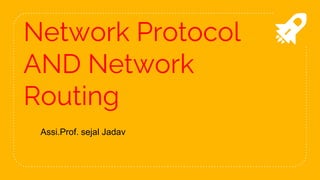
01 packet
- 1. Network Protocol AND Network Routing Assi.Prof. sejal Jadav
- 2. What is packet? ● Definition: A packet is one unit of binary data capable of being routed through a computer network. To improve communication performance and reliability(trustable), each message sent between two network devices is often subdivided into packets by the underlying hardware and software. 2
- 3. ● Packets are constructed in some standard packet format. ● Packets and datagram are similar. ● Packets have following things: ● Header: contains source and destination address ● Data: original data which we want to transmitted. ● Trailer: it marks the end of the packet and also contains error checking. 3
- 4. 4
- 5. Q. What is protocol?
- 6. ● Q. What is protocol? ● A network protocol defines rules and conventions for communication between network devices. ● A protocol is a set of rules to given the data transfer between the devices. 6
- 7. ● The rules are used for the following purposes. 1. For compressing the data. 2. For sending device to indicate that it has finished sending a message. 3. For receiving device to indicate that it has received a message. 7
- 8. ● There are different types of Protocol such as: ● 1. Transmission control Protocol (TCP) 2. Internet Protocol (IP) 3. Internet Address Protocol (IP Address) 4. Post office Protocol (POP) 5. Simple mail transport Protocol (SMTP) 6. File Transfer Protocol (FTP) 7. Hyper Text Transfer Protocol (HTTP) 8
- 9. ● Q: Give the types of protocol. ● Protocols are divided into two categories based on their use of connections: 1) Connection-Oriented Protocols: 2) Connectionless Protocols: 9
- 10. 1) Connection-Oriented Protocols: ● These protocols require that a logical connection be established between two devices before transferring data. ● Usually one device begins by sending a request to open a connection, and the other responds. They pass control information to determine if and how the connection should be set up. 10
- 11. ● If this is successful, data is sent between the devices. When they are finished, the connection is broken. ● Connection-oriented communication is more reliable(trustable) then connectionless communication ● Example : TCP 11
- 12. ● Q: Explain TCP ● The Transmission Control Protocol(TCP) is an internetwork connection-oriented protocol that corresponds to the OSI Transport layer. ● TCP provides full-duplex, end-to-end connections. 12
- 13. 13
- 14. ● TCP maintains a logical connection between the sending and receiving computer systems. In this way, the integrity(error free ) of the transmission is maintained. ● TCP detects any problems in the transmission quickly and takes action to correct them. 14
- 15. 2) Connectionless Protocols: ● These protocols do not establish a connection between devices. As soon as a device has data to send to another, it just sends it. ● Communication is not reliable. ● Example: UDP 15
- 16. ● Q: Explain UDP. ● The User Datagram Protocol (UDP) is one of the core members of the Internet protocol suite. ● The protocol was designed by David P. Reed in 1980 and formally defined in RFC 768. ● Note: Postel [page 1] 28 Aug 1980 User Datagram Protocol RFC 768 Fields Destination Port has a meaning within the context of a particular internet destination address. 16
- 18. David P. Reed (American computer scientist) 18
- 19. ● There is no guarantee of delivery, ordering, or duplicate protection. ● UDP provides checksums for data integrity (error free), and numbers for addressing different functions at the source and destination of the datagram(Packet). 19
- 20. Q- what is TCP/IP ?... 20
- 21. ● Note: Remote System ? ● Remote computers can be quite handy in certain scenarios. ● They can be helpful when a user forgot some of his/her files in their home or office computer and wants to access and retrieve them even though it is no longer physically possible. ● They can also be very useful in business environments, when holding conferences and computer maintenance or assistance. 21
- 22. Q. Explain FTP (File Transfer Protocol).
- 23. ● Q. Explain FTP (File Transfer Protocol). ● FTP is built on a client-server architecture and uses separate control and data connections between the client and the server ● FTP is standard internet protocol used to exchange files between computers on internet. 23
- 24. ● FTP is an application protocol that uses the internet’s TCP/IP protocols. ● FTP is commonly used for transfer web pages files from their creator to the server. ● FTP is also used to download web pages. ● Using FTP user can update, delete, rename, move, copy file at server. 24
- 25. ● FTP Commands 1) ? : information about the FTP commands. 2) ASCII: Set the file transfer mode to ASCII (Note: this is the default and transmits seven bits per byte). 3) Binary: Set the file transfer mode to binary (Note: the binary mode transfers all eight bits per byte and must be used to transfer non-ASCII files). 25
- 26. ● CD: Change directory on the remote system. ● Close: Terminate a session with another system. ● Delete: Delete (Remove) a file in the current directory. 26
- 27. ● Dir: List all the content of the directory. ● Get: Copy a file from the remote system to the local system. ● Help: Request a list of all available FTP commands. This command does not require a connection to a remote system 27
- 28. ● Mkdir: Make a new directory within the current remote directory. ● Open: Open a connection with another system. ● Quit: Exit FTP environment. This command does not require a connection to a remote system. ● Rmdir: Remove a directory in the current directory. 28
